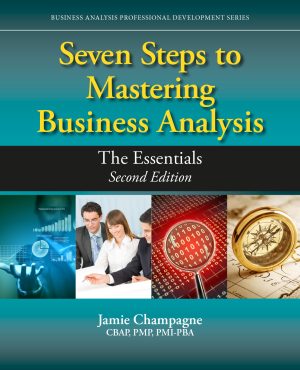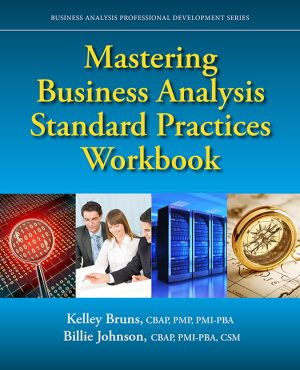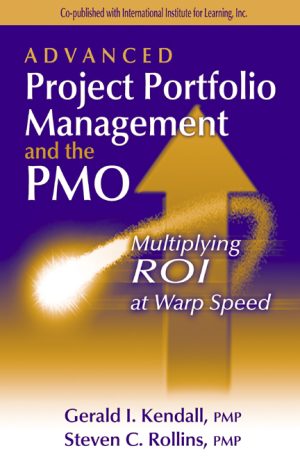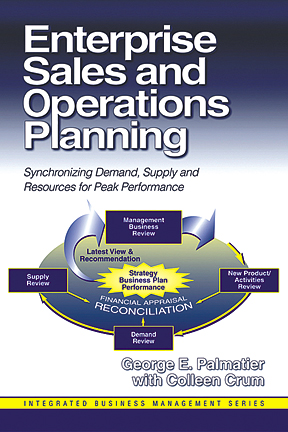Mastering Business Analysis Standard Practices
$59.95
Seven Steps to the Next Level of Competency
Kelley Bruns, CBAP, PMI-PBA, PMP, PMI-ACP, CSM, and Billie Johnson, CBAP, PMI-PBA, CSM
Softcover, 7.5×9.25, 400 pages
ISBN: 978-1-60427-138-6
e-ISBN: 978-1-60427-805-7
March 2019
LEARN & EARN: Get 9.0 PDUs in the PMI skill areas of Technical, Leadership, or Strategic and Business Management Skills.
Part of the Business Analysis Professional Development Series
Description
This volume in the Business Analysis Professional Development Series presents all the standard practices for performing business analysis work across seven steps, five perspectives, and 74 techniques. It will help business analysts at all levels further develop their skills and capabilities and master the next, or intermediate, level of competency in business analysis needed to advance their careers.
This reference provides valuable guidance to everyone who performs BA work, uses BA deliverables, reviews or approves BA deliverables, or manages or mentors BA practitioners. It will help readers comprehend the BA role, responsibilities, and deliverables that ensure business analysis success.
For instructors, trainers, and students, the supplemental Mastering Business Analysis Standard Practices Workbook, designed to be used in conjunction with the main text, enables readers to practice the seven-step process they are learning with a realistic case study, exercises, and suggested solutions. It helps facilitate self-learning and course instruction effectively where users can engage the processes before applying them on their own projects.
Key Features
- Presents a structured step-by-step process for performing business analysis that any new or experienced practitioner could follow, rather than having to piece the process together themselves
- Addresses stakeholder identification and thoroughly examines stakeholder analysis and management to ensure a deep understanding before planning or engaging stakeholder involvement
- Discusses how to perform situational needs analysis and prepare situational justification for decision makers within the business context
- Demonstrates how to plan the business analysis work effort and develop and execute communication and information management plans
- Shows how to set up a project for success with a clear and concise scope definition boundary, maintain agreement on scope, and control scope in an ever-changing environment
- Provides detailed guidance on developing solution requirements and design definition for building the solution to meet stakeholder needs
- Details the business analysis practitioner’s role as the solution is being built; throughout the solution’s existence; and after to ensure proper value is achieved
- Defines BA and project management collaboration opportunities that lead to successful solution results
- Covers business analysis terminology, roles and responsibilities, perspectives, competencies, and the expanded multi-level career path of a business analyst
- WAV offers downloadable Business Analysis Referenced Templates—available from the Web Added Value Download Resource Center at www.jrosspub.com/wav
About the author(s)
Kelley Bruns, CBAP®, CSM, PMI-ACP®, PMI-PBA®, PMP®, ICP, ICP-APM, ICP-BVA
Kelley Bruns, President of Bruns Consulting, LLC, is a veteran corporate trainer, mentor, training manager, course developer, and author with more than 25 years of experience helping enterprise project teams solve problems. She is a former Vice President of BA Training at ASPE and a leading expert in business analysis and various approaches to project management and product development. She holds a Master’s degree in Adult Education with a concentration in Training and Development from Drake University. Ms. Bruns was actively involved in the IIBA Enhanced Certification Redesign and the Endorsed Education Provider Advisory Group.
Kelley is a Project Management Institute certified Project Management Professional (PMP®), Professional in Business Analysis (PMI-PBA®), and Agile Certified Practitioner (PMI-ACP®). She is also a Scrum Alliance accredited Certified Scrum Master (CSM), and International Consortium for Agile accredited ICP, ICP-BVA, and ICP-APM. Kelley has dedicated her career to helping people transfer knowledge and develop skills and abilities in both professional and personal settings to provide a strong return on investment. She is uniquely talented at helping others learn best practices without having to learn the hard way.
Billie Johnson, CBAP®, PMI-PBA®, CSM, IIBA-EEP
Billie Johnson, an independent trainer and consultant, is a leading business analysis expert and practicing professional who has been involved in establishing business analysis direction, processes, and modeling for almost 30 years—spanning the financial, manufacturing, consulting, education, government, retail, and mining industries. She was an early adopter of the IIBA® Certified Business Analysis Professional™ (CBAP®) certification, receiving her CBAP® in May 2007; as well as the PMI Professional in Business Analysis (PMI-PBA®) certification achieved as soon as it was offered in July 2014. She is also a Certified Scrum Master (CSM) accredited by the Scrum Alliance.
Billie was a reviewer team lead for the IIBA BABOK Guide® Version 3.0. She periodically speaks at IIBA and PMI events and other professional conferences. For the last ten years, she has been teaching and consulting with large organizations and Fortune 500 companies. As a business analysis instructor, course developer, author, coach, and mentor, she enjoys furthering the field of business analysis by giving practitioners the tools to face head on their unique problems and opportunities.
Table of Contents
Chapter 1 – Introduction
What is Business Analysis?
Who does Business Analysis?
What Qualities do Business Analysts Possess?
What Are the Business Analyst Organizational Structures?
BA Career Progression
Business Analysis Competencies
Business Analysis Perspectives
Key Business Analysis Terms/Concepts/Definitions
Business Analysis Center of Excellence and Business Analysis Community of Practice
Hone your Business Analysis Information Elaboration Techniques
Business Analysis Journey Map
Summary of Key Points
Bibliography
Chapter 2 – Step 1: Understand Your Stakeholders
Five Perspectives Table Showing Stakeholder Understanding
Types of Stakeholders
Understand Your Stakeholders’ Motivations
Trust – It’s the game changer
Ongoing Stakeholder Analysis
Techniques
Summary of Key Points
Bibliography
Chapter 3 – Step 2: Understand the Business Context
Five Perspectives Table Showing Business Context
Understand the Enterprise Architectural Direction
Enterprise Architecture Components
Understand the Organization’s Business Drivers
Frequently Identified Business Drivers
Understand the Business Case
Techniques
Summary of Key Points
Bibliography
Chapter 4 – Step 3: Plan the Business Analysis Work
Five Perspectives Table Showing Planning Business Analysis Work
Iterative Nature of Elicitation, Collaboration and Analysis
Where to Begin Planning
Plan the Business Analysis Work Activities
Justify the Business Analysis Effort
Business Analysis Assessment
Techniques
Summary of Key Points
Bibliography
Chapter 5 – Step 4: Set Initiative Scope
Five Perspectives Table Showing Initiative Scope Setting
What is Scope?
Focus on “Why” First Before “What”
Develop Success Measures
Now What? – “Chunkify” the Initiative
Solution Stakeholder Impact and Scope Definition
Gain Consensus on Scope Definition
Techniques
Summary of Key Points
Bibliography
Chapter 6 – Step 5: Develop Solution Requirements and Design Definition
Five Perspectives Table Showing Solution Requirements Development and Design Definition
Decompose Scope Definition to Effective Solution Requirements
Decompose Solution Requirements to Effective Design Definition
Doneness? How Do I Know When I’m Done?
Techniques
Summary of Key Points
Bibliography
Chapter 7 – Step 6: Scope Management
Five Perspectives Table Showing Scope Management
Verify Requirements
Validate Requirements
Recommend Solution(s)
Monitor Requirements and Design Definition
Scope Change
Techniques
Summary of Key Points
Bibliography
Chapter 8 – Step 7: Evaluate the Solution
Five Perspectives Table Showing Solution Evaluation
Evaluate Proposed Solutions
Recommend Actions to Increase Solution Value
Support Implementation SMEs
Support Testers
Assess Organizational Readiness
Develop Transition Requirements
Measure Solution Success
Techniques
Summary of Key Points
Bibliography
Glossary
Index
Reviews
“The real-life examples alone set this business analysis book apart from the others because you can see what really works in a variety of scenarios. It underscores the concept that not every tool is applicable to every effort and offers guidance for selecting the right tools for the right situation. This reference is not only relevant to BA generalists, but also for specialists or those considering specializing in a business analysis perspective. This is the first BA-related publication I’ve seen that offers that.”
—Colleen Meesey, CBAP, Product Manager, International Institute of Business Analysis (IIBA)
“Mastery of business analysis skills is more important than ever. Bruns and Johnson have authored an invaluable guide for those who want a practical, actionable understanding of how to improve project success through business analysis practices. This should be required reading for all business analysts!”
—Andy Kaufman, PMP, Speaker, Author, Executive Coach, Institute for Leadership Excellence & Development Inc.
“The authors’ insight, experience, and anecdotal humor into the practical application of business analysis is a much-needed literary contribution to a fast-emerging BA profession that requires communication, critical thinking, and a dash of collaborative genius.”
—Todd Britton, CBAP, CSM, Director of Program Management Office, NY State Office of State Comptroller
You may also like…
-

Seven Steps to Mastering Business Analysis, 2nd Edition
Retail Price: $69.95$59.95 Add to cart -

Successful Business Analysis Consulting
Retail Price: $32.95$29.95 Add to cart -

Mastering Business Analysis Standard Practices Workbook
Retail Price: $24.95$19.95 Add to cart -

Mastering Business Analysis Versatility
Retail Price: $69.95$59.95 Add to cart
Related products
-

Advanced Project Portfolio Management and the PMO
Retail Price: $74.95$59.95 Add to cart -

Enterprise Sales and Operations Planning
Retail Price: $54.95$49.95 Add to cart -

Financially Focused Project Management
Retail Price: $54.95$44.95 Add to cart -

Achieving Project Management Success Using Virtual Teams
Retail Price: $49.95$39.95 Add to cart -

Distressed Debt Analysis
Retail Price: $119.95$99.95 Add to cart

